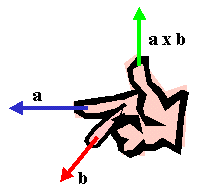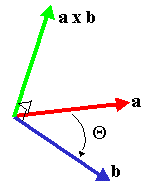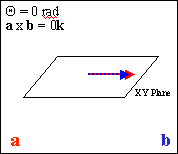There is another way that two vectors can be multiplied. While the dot product
of two vectors produces a scalar, the cross product of two vectors is a
vector. As such, it has both magnitude and direction. The
cross product of the vectors ![]() and
and ![]() is written as
is written as
![]() and has a magnitude given by
and has a magnitude given by
![]()
where ![]() is the angle between the two vectors.
is the angle between the two vectors.
The direction of the cross product is perpendicular to both of the vectors. To get the correct orientation, use the right-hand rule. Point your index finger (of your right hand) along the first vector. Then orient your hand so that your middle finger points along the second vector. Extend your thumb. It points in the direction of the cross product.


Notice that the greater the angular separation of the two vectors, the larger the cross product's magnitude.

When the angle between the vectors is greater than 180 degrees, the cross product flips over to point in the opposite direction.
Now let's calculate some simple cross products.
Try calculating the cross product of the basis vectors in other combinations.